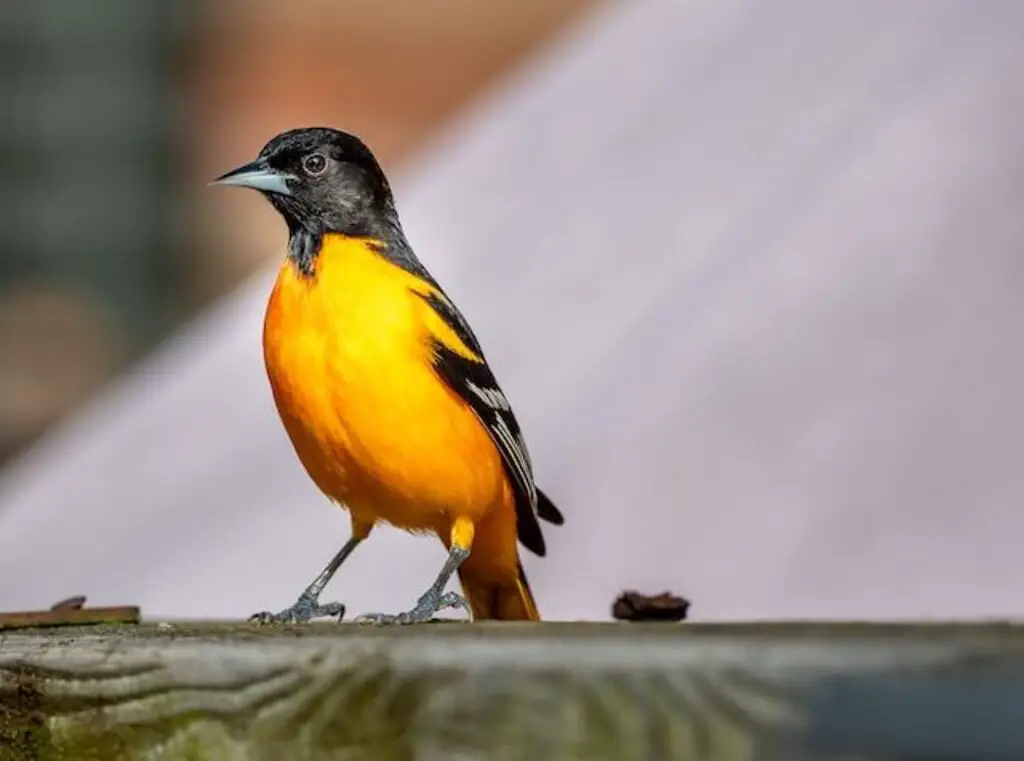Do Baltimore Orioles Eat Dried Mealworms? Find out the juicy truth as we delve into the culinary preferences of these vibrant avian creatures.
Prepare to uncover the secrets of their menu choices, discover surprising feeding habits, and learn how to attract these delightful visitors to your backyard.
Spoiler alert: there may be some mouth-watering surprises along the way!
Table of Contents
- 1 Baltimore Orioles: A Brief Introduction
- 2 The Diet of Baltimore Orioles
- 3 What Are Dried Mealworms?
- 4 Do Baltimore Orioles Eat Dried Mealworms?
- 5 When to Feed Orioles Mealworms?
- 6 Should I Soak Dried Mealworms?
- 7 How Do You Feed Orioles Mealworms?
- 8 How To Feed Mealworms Properly To A Baby Oriole?
- 9 Proper Storage Guidelines for Dried Mealworms
- 10 The Nutritional Value of Dried Mealworms
- 11 Studies on Baltimore Orioles and Dried Mealworms
- 12 Observations from Birdwatchers
- 13 Tips for Offering Dried Mealworms to Baltimore Orioles
- 14 Other Foods Baltimore Orioles Enjoy
- 15 Importance of Proper Nutrition for Birds
- 16 Conclusion: Should You Offer Dried Mealworms to Baltimore Orioles?
- 17 Frequently Asked Questions
- 17.1 What is the migration pattern of Baltimore Orioles?
- 17.2 How can you attract Baltimore Orioles to your backyard?
- 17.3 Are there any potential health risks associated with feeding Baltimore Orioles dried mealworms?
- 17.4 Can other bird species also benefit from eating dried mealworms?
- 17.5 Are there any alternative sources of protein that Baltimore Orioles can consume besides dried mealworms?
- 17.6 How long do dried mealworms last before they go bad?
- 17.7 Can you feed live mealworms to baby Orioles?
- 17.8 Do Orioles prefer mealworms over other types of insects?
- 17.9 Is it safe to leave mealworms out in the rain for Orioles to eat?
- 17.10 Can you mix mealworms with other types of birdseed to feed Orioles?
- 18 Conclusion
- 19 Author
Baltimore Orioles: A Brief Introduction
The Baltimore Oriole, a brightly colored passerine bird native to North America, is known for its distinctively melodic song and foraging habits that include consuming a variety of insects.
These birds prefer to live in open woodlands, parks, and gardens with tall trees, and they migrate between North and Central America.
They are monogamous and build intricate hanging nests, often using plant fibers and animal hair, where females lay their eggs.
Baltimore Orioles face numerous predators and threats, including habitat loss, pesticide use, and collisions with buildings.
Conservation efforts have been made to protect their habitats and raise awareness about their importance in ecosystems.
The population status of Baltimore Orioles is currently stable, although some subspecies are considered vulnerable.
These birds have symbolic and cultural significance, appearing in folklore and legends as a symbol of happiness and good fortune.
They have also been represented in various forms of art, including paintings and sculptures.
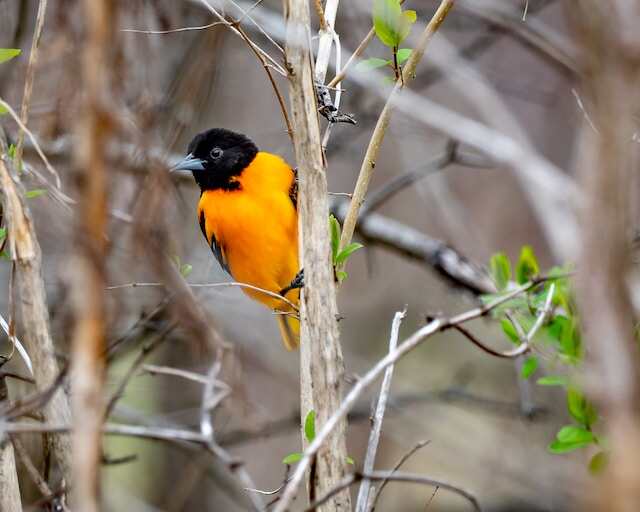
The Diet of Baltimore Orioles
Baltimore Orioles’ diet primarily consists of insects and fruit, which provides them with the necessary nutrients for energy and survival.
Their feeding habits include gleaning insects from the foliage, hovering to catch insects in mid-air, and sipping nectar from flowers.
Orioles have a strong preference for sweet fruit, such as oranges and berries, and will often be seen pecking at them to get the juice.
They are also known to forage for insects on the ground, picking them up with their sharp beaks.
While dried mealworms are not a natural part of their diet, some bird enthusiasts have reported success in attracting Baltimore Orioles with this high-protein snack.
Overall, Baltimore Orioles have a diverse diet and are opportunistic feeders, adapting to their environment and food availability.
What Are Dried Mealworms?
Dried mealworms are a high-protein snack that can be used as a potential food source for certain bird species, providing an alternative dietary option for bird enthusiasts.
These dried mealworms are actually larvae of darkling beetles and are widely available in pet stores or online.
The benefits of feeding dried mealworms to birds are numerous, as they are a rich source of protein, healthy fats, and essential vitamins and minerals that can support bird growth and development.
Preparation of dried mealworms is quite simple, as they can be fed directly or mixed with other bird foods.
Overall, dried mealworms can be a great addition to a bird’s diet, and provide a convenient and nutritious snack for bird enthusiasts.
Do Baltimore Orioles Eat Dried Mealworms?
Baltimore Orioles are a vibrant and colorful bird species known for their distinctive orange plumage and melodious songs. These birds are a common sight in many parts of North America, including parks, gardens, and woodlands.
With a diet that mainly consists of fruits, nectar, and insects, Baltimore Orioles are active foragers that require a diverse range of nutrients to maintain their health and vitality.
One particular food item that bird enthusiasts often wonder about is dried mealworms. These tiny, protein-packed insects are a popular choice for feeding backyard birds, but do Baltimore Orioles eat them?
Yes, Baltimore Orioles do eat dried mealworms. These protein-rich treats are a popular choice for attracting Orioles to your backyard.
Offering dried mealworms in feeders or scattered on feeding platforms can entice Orioles and provide them with a nutritious food source.
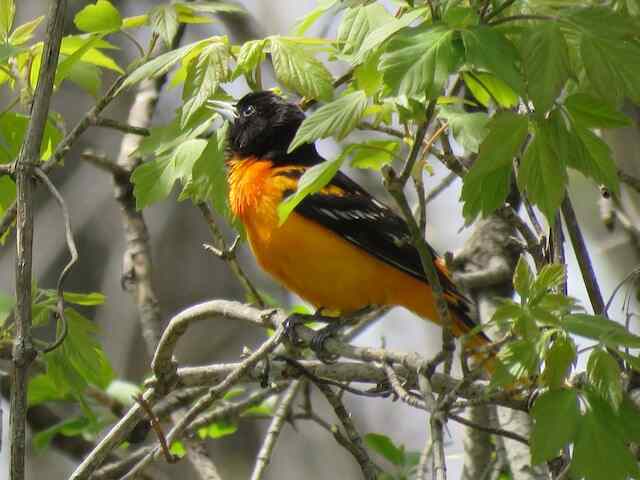
When to Feed Orioles Mealworms?
Feed Orioles mealworms during their breeding season from late spring to early summer for optimal nutrition. Enhance their diet with this nourishing option. This is when they are actively nesting and raising their young.
Providing mealworms during this time can be beneficial, as they are a high-protein food source that can help support the Orioles’ increased energy needs during breeding.
It is also important to note that Orioles may continue to visit feeders and consume mealworms even after the breeding season, as they are still valuable sources of nutrition.
Should I Soak Dried Mealworms?
Soaking dried mealworms is not necessary for Baltimore Orioles. These birds have a preference for insects, and they can consume dried mealworms without soaking them.
However, if you choose to soak the mealworms, it can make them softer and more similar to live insects, which might be beneficial if you’re trying to attract Orioles that are not accustomed to dried food.
Some bird enthusiasts have reported success with soaking dried mealworms in water or fruit juice for a short period before offering them to the birds.
Ultimately, whether you decide to soak the dried mealworms is up to your personal preference and the behavior of the Orioles in your area.
How Do You Feed Orioles Mealworms?
Place Mealworms on Nectar-Filled Feeder:
- Fill a nectar feeder with a mixture of sugar water (4 parts water to 1 part sugar).
- Place the dried mealworms on top of the nectar-filled feeder.
- Orioles will be attracted to the feeder for both the nectar and the mealworms.
Stick Food Container to Feeder:
- Attach a small food container, such as a plastic cup or dish, to the Oriole feeder.
- Fill the container with dried mealworms.
- Orioles can easily access the mealworms from the container while visiting the feeder.
Replace Jelly with Mealworms:
- If you typically offer grape jelly to attract Orioles, consider replacing it with dried mealworms.
- Orioles have a natural preference for insects, and offering mealworms can be a more nutritious alternative.
- Place the mealworms on a dish or directly on the feeder as a substitute for jelly.
Hang Feeder Dish near Oriole Feeder:
Hang a separate dish or feeder near the Oriole feeder specifically for dried mealworms.
Place a small amount of mealworms in the dish, ensuring they are easily accessible to the Orioles.
This provides an additional feeding option and encourages Orioles to visit your feeding station.
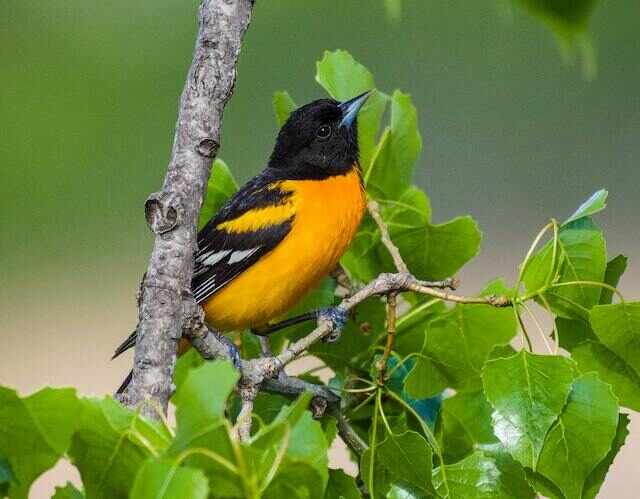
How To Feed Mealworms Properly To A Baby Oriole?
Feeding baby Orioles requires special care and attention. Here are some guidelines to consider when determining how many mealworms to feed a baby Oriole:
- Soak the mealworms: Before feeding mealworms to a baby Oriole, it is recommended to soak them in warm water. This softens the mealworms, making them easier for the bird to consume.
- Feeding method: You can feed the soaked mealworms to the baby Oriole using a pair of forceps. This allows for precise feeding and mimics the way parent birds feed their chicks in the wild.
- Feeding frequency: In the early stages, when the Oriole is very young, feeding may be required as often as every 15 to 25 minutes. This feeding frequency replicates the natural feeding behavior seen in the Oriole’s natural habitat.
Please note that these are general guidelines, and it’s important to consult with experts or experienced bird rehabilitators for specific advice on caring for baby Orioles. Their guidance can ensure the best possible care for the bird’s health and development.
Proper Storage Guidelines for Dried Mealworms
Dried mealworms can be stored easily by following some simple instructions. Here are the steps to store dried mealworms properly:
- Choose a suitable container: Select an airtight container that can keep out moisture and pests. Glass or even plastic containers with tight-fitting lids work well.
- Ensure a cool and dry location: Find a cool and dry place to store the container. The ideal temperature for storage is below 70°F (21°C). Avoid areas with high humidity or direct sunlight, as these can cause the mealworms to spoil or lose nutritional value.
- Package the dried mealworms: If the dried mealworms are not already packaged, place them in resealable bags or airtight containers. This will help maintain their freshness and prevent moisture from entering.
- Remove excess air: Squeeze out as much air as possible from the packaging before sealing it. Oxygen can cause the mealworms to deteriorate faster, so minimizing air exposure is important.
- Label and date the container: To keep track of the storage time, label the container with the date of storage. This will help you ensure that you consume the oldest mealworms first.
- Check for signs of spoilage: Periodically inspect the stored mealworms for any signs of mold, unusual odors, or insect infestation. If you notice any of these signs, discard the affected batch.
By following these steps, you can store dried mealworms for up to six months while maintaining their quality and nutritional value.
Remember to check the expiration date if you purchased the dried mealworms commercially, as it may vary depending on the specific product.
The Nutritional Value of Dried Mealworms
The nutritional benefits of dried mealworms are abundant, making them a valuable addition to bird diets due to their high protein content and essential vitamins and minerals.
Here are some key nutritional benefits of dried mealworms that make them a great food source for birds:
- High protein content: Dried mealworms are an excellent source of protein, containing up to 50% protein by weight. This high protein content makes them a great food source for birds, as protein is essential for growth, development, and overall health.
- Essential vitamins and minerals: Dried mealworms are also rich in essential vitamins and minerals, including calcium, iron, and B vitamins. These nutrients are important for maintaining strong bones, healthy blood cells, and overall metabolic function.
- Sustainable food source: Dried mealworms are a sustainable food source, as they can be produced using less land, water, and resources than traditional livestock. This makes them an environmentally friendly option for bird diets.
- Versatile preparation methods: Dried mealworms can be prepared in a variety of ways, including soaking, roasting, and crushing. This versatility makes them easy to incorporate into bird diets and can help keep birds interested in their food.
- Affordable option: Dried mealworms are an affordable option for bird diets, especially when compared to other high protein food sources like live insects or meat-based products. This makes them a great option for bird enthusiasts looking to provide their feathered friends with a nutritious and cost-effective diet.
Here’s a simple table showcasing the nutritional value of dried mealworms per 100 grams:
| Nutrient | Amount |
|---|---|
| Protein | 53 grams |
| Fat | 30 grams |
| Fiber | 7 grams |
| Carbohydrates | 13 grams |
| Calcium | 0.07 grams |
| Iron | 1.36 grams |
| Vitamin B12 | 1.1 mcg |
| Vitamin E | 1.85 mg |
| Phosphorus | 0.70 grams |
| Potassium | 370 mg |
Please note that these values may vary slightly depending on the source and processing methods of the dried mealworms.
Overall, dried mealworms offer a range of nutritional benefits and sustainability concerns, making them a great addition to bird diets.

Studies on Baltimore Orioles and Dried Mealworms
Recent studies have explored the potential benefits of incorporating dried mealworms into the diets of certain bird species.
Among these birds are Baltimore Orioles, which have been observed displaying feeding preferences for insects over fruits and nectar.
Dried mealworms have been found to be a good source of protein, fat, and other essential nutrients that are important for bird health and survival.
In addition, dried mealworms are easy to store and transport, making them a convenient food source for birds that feed on insects.
Studies have also shown that the inclusion of dried mealworms in bird diets can improve bird behavior and increase breeding success rates.
While more research is needed to fully understand the nutritional benefits of dried mealworms for Baltimore Orioles, it is clear that they are a promising food source that can help support the health and well-being of these birds.
Observations from Birdwatchers
Birdwatchers have reported sightings of a certain species of bird indulging in a protein-rich food source that is commonly found in the wild, providing them with an essential source of energy to carry out their daily activities.
Observations from birdwatchers suggest that Baltimore Orioles do eat dried mealworms, especially during their migration patterns.
These observations have led to further research on bird behavior and feeding habits, as well as the impact of dried mealworms on bird health.
While more studies are needed to fully understand the effects of dried mealworms on Baltimore Orioles, these observations provide valuable insights into the dietary habits of this species and their ability to adapt to changing food sources in the wild.
Tips for Offering Dried Mealworms to Baltimore Orioles
Providing a protein-rich food source, such as dried mealworms, can be a valuable addition to the diet of certain bird species and may aid in their ability to adapt to changes in their natural food sources.
When it comes to offering dried mealworms to Baltimore Orioles, there are a few tips to keep in mind.
Firstly, feeder placement is key – these birds prefer to feed in open areas, so placing the feeder in a visible location is important.
Secondly, choose the right feeder type – orioles prefer feeders that are shallow and have perching space, such as fruit feeders or jelly dishes.
Lastly, feeder maintenance is crucial to keep the food fresh and prevent the spread of diseases.
Regular cleaning and disinfection of the feeder can help keep the birds healthy and happy.
By following these tips, bird enthusiasts can provide a nutritious food source for Baltimore Orioles and enjoy observing these beautiful birds in their backyard.
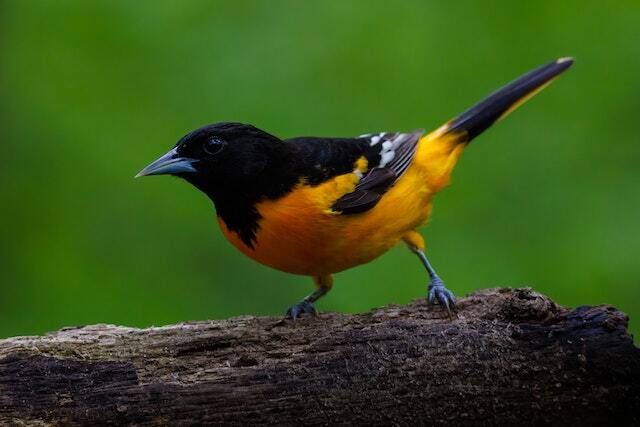
Other Foods Baltimore Orioles Enjoy
Baltimore Orioles also enjoy a variety of fruits, including oranges, grape jelly, and sliced grapes, which can be offered in shallow feeders with perching space.
In addition to dried mealworms, these birds are known to be attracted to nectar feeders and fruit trees.
A bird feeder filled with sweet nectar can be a great way to entice orioles to visit your yard, while planting fruit trees such as cherry or apple can provide a natural food source for these beautiful birds.
By offering a variety of foods, bird enthusiasts can create a diverse and attractive feeding environment for Baltimore Orioles.
Importance of Proper Nutrition for Birds
A balanced and nutritious diet is crucial for the overall health and wellbeing of birds, and providing a variety of foods such as fruits, nectar, and seeds can ensure they receive the necessary nutrients for optimal physical and physiological functioning.
Birds require a specific mix of proteins, vitamins, minerals, and carbohydrates to maintain their energy levels and support their immune systems.
The benefits of providing a diverse assortment of foods for birds include improved feather quality, better breeding success, and longer lifespans.
Additionally, the timing of when food is offered can also impact a bird’s health, as some species require more frequent feedings than others.
Overall, providing a balanced and varied diet is essential for the health and happiness of birds, and should be a top priority for bird owners and enthusiasts.
Conclusion: Should You Offer Dried Mealworms to Baltimore Orioles?
The inclusion of a protein-rich food source such as dried mealworms in the diet of certain bird species can offer a convenient and beneficial addition to their feeding regimen.
Baltimore Orioles, specifically, are known to occasionally consume mealworms, although they primarily feed on fruits, nectar, and insects.
Benefits of offering mealworms to birds include their high protein content, which can aid in growth and development, and their convenience as a readily available food source.
However, there are also drawbacks to consider, such as the potential for mealworms to carry harmful bacteria if not properly stored and handled.
Additionally, some bird enthusiasts may prefer to offer alternative food options that are more natural to the bird’s diet.
Ultimately, the decision to offer dried mealworms to Baltimore Orioles or other bird species should be based on careful consideration of the benefits and drawbacks, as well as the individual bird’s specific nutritional needs.
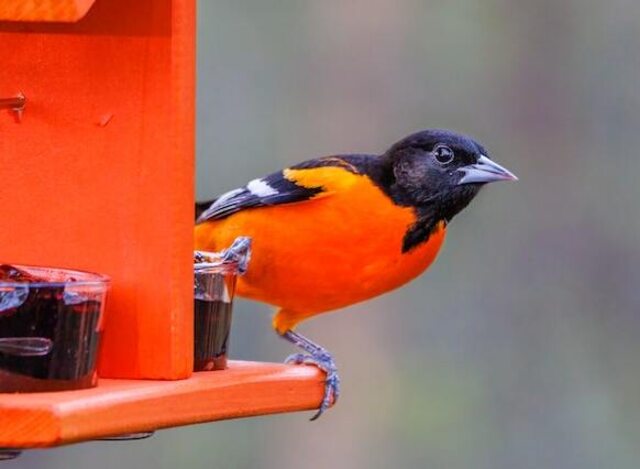
Frequently Asked Questions
What is the migration pattern of Baltimore Orioles?
Baltimore orioles are migratory birds that breed in North America during the summer months and winter in Central America and northern South America. Their migration routes vary depending on their breeding location, with birds that breed in the eastern United States typically following a route that takes them across the Gulf of Mexico.
During the winter months, these birds can be found in a variety of habitats, including forests, plantations, and gardens. While little is known about their wintering habits, it is likely that they feed primarily on fruit.
Baltimore orioles typically nest in deciduous trees and shrubs, and their breeding grounds are located across much of eastern and central North America. Overall, the migration patterns of Baltimore orioles demonstrate their adaptability and ability to thrive in a variety of habitats, making them a fascinating subject for research and study.
How can you attract Baltimore Orioles to your backyard?
Attracting Baltimore Orioles to your backyard can be accomplished through various means. Installing bird feeders with nectar, fruit, and jelly can entice these brightly colored birds to your garden.
Fruit trees, such as cherry, apple, and plum, are also attractive to orioles as they enjoy feeding on the sweet fruit. Additionally, adding a water feature such as a bird bath or fountain can provide a source of hydration that these birds need.
By incorporating these elements into your backyard, you can create an environment that appeals to the natural preferences of Baltimore Orioles and increases the likelihood of spotting these beautiful birds in your yard.
Are there any potential health risks associated with feeding Baltimore Orioles dried mealworms?
Dried mealworms have become a popular food source for birds, including the Baltimore oriole, due to their high nutritional value. While they are an excellent source of protein, vitamins, and minerals, there are potential health risks associated with feeding birds dried mealworms.
For instance, if not stored properly, dried mealworms can become contaminated with bacteria and fungi, leading to possible illness or death in birds. Additionally, feeding dried mealworms too frequently can cause imbalances in the bird’s diet, leading to nutritional deficiencies.
Therefore, it is important to use caution when feeding birds dried mealworms and to ensure that they are stored properly and fed in moderation.
Can other bird species also benefit from eating dried mealworms?
Feeding habits of birds vary greatly depending on the species. However, many bird enthusiasts have discovered that feeding dried mealworms can provide a nutritional boost to their feathered friends.
Dried mealworms are a great source of protein and fat, which can be especially beneficial to birds during the breeding season when they need to maintain their energy levels.
When considering the compatibility of other bird species with dried mealworms, it is important to note that not all birds will take to them. Some birds may prefer other food sources, while others may have difficulty digesting the mealworms.
However, many species, including bluebirds, chickadees, and wrens, have been observed eating dried mealworms with great enthusiasm. Overall, feeding birds dried mealworms can be a great way to provide them with a nutritional boost, but it is important to observe their feeding habits and preferences to ensure compatibility.
Are there any alternative sources of protein that Baltimore Orioles can consume besides dried mealworms?
Birds, especially Baltimore Orioles, have unique feeding preferences that dictate their dietary needs. Insect alternatives are becoming increasingly popular as a source of protein for birds, offering a range of essential nutrients. While dried mealworms are a common feeding choice for Baltimore Orioles, there are other insect alternatives that offer similar nutritional value.
For example, crickets, grasshoppers, and waxworms are all excellent sources of protein, fat, and minerals like calcium, iron, and phosphorus. In addition to insect alternatives, Baltimore Orioles can also consume fruits, nectar, and jelly, which provide a variety of vitamins and minerals. Therefore, it is important to offer a diverse range of foods to meet the nutritional requirements of these birds.
How long do dried mealworms last before they go bad?
Dried mealworms are a popular source of protein for many animals, including birds, reptiles, and fish. When properly stored, dried mealworms can last for several months before they go bad.
The key to storing mealworms is to keep them in a cool, dry place, away from direct sunlight. It is also important to check the expiration date on the packaging and use the mealworms before that date.
If the mealworms appear to be dry or shriveled, they may have lost their nutritional value and may not be as effective as a food source. To rehydrate mealworms, simply soak them in water for a few minutes before feeding them to your pets.
By following these guidelines, you can ensure that your dried mealworms remain fresh and nutritious for as long as possible.
Can you feed live mealworms to baby Orioles?
Feeding baby orioles can be a challenging task for bird enthusiasts. The feeding schedule and techniques are crucial factors that must be considered to ensure the nutritional value of the food.
Live mealworms are often considered a suitable food source for baby orioles due to their high protein content. However, feeding techniques must be followed carefully to prevent choking hazards and other potential risks.
It is important to note that baby orioles should only be fed by experienced caretakers, as improper feeding can lead to serious health issues. It is also recommended to consult with a veterinarian or an experienced bird specialist to determine the specific feeding requirements of your baby oriole.
Do Orioles prefer mealworms over other types of insects?
Orioles are known for their preference for insects, specifically caterpillars, beetles, and ants. However, mealworms are a popular alternative for bird enthusiasts who want to attract orioles to their feeders.
Mealworms are high in protein and fat, making them a nutritious option for birds. However, it is important to note that orioles do not rely solely on mealworms for their diet. They also consume nectar from flowers and fruits.
Additionally, offering a variety of insects, such as crickets and grasshoppers, can provide a diverse range of nutrients for orioles. Therefore, while mealworms can be a beneficial addition to an oriole’s diet, they should not be the sole source of nutrition.
Is it safe to leave mealworms out in the rain for Orioles to eat?
Rainy day dilemmas can pose a challenge for bird enthusiasts who want to feed their feathered friends. Oriole feeding habits are well documented, but the question remains: is it safe to leave mealworms out in the rain for orioles to eat?
Mealworm storage is a crucial aspect of bird feeding, as these insects can easily mold or rot if not stored correctly.
While orioles do enjoy mealworms, it’s important to keep them dry and fresh. Leaving them out in the rain can lead to spoilage, which can harm the birds’ health.
To combat this, bird lovers can purchase a mealworm feeder that protects the insects from the elements.
This innovative solution not only keeps the mealworms fresh, but it also provides a fun and interactive way for orioles to feed.
By incorporating a mealworm feeder into their bird feeding routine, enthusiasts can ensure that their feathered friends are getting the nutrition they need, even on a rainy day.
Can you mix mealworms with other types of birdseed to feed Orioles?
Mixing mealworms with other types of birdseed is a great way to provide a varied diet for orioles. These birds are known to be insectivores, and mealworms are a great source of protein for them.
However, it is important to note that orioles also enjoy fruits and nectar, so it is important to mix mealworms with other types of birdseed, such as sunflower seeds, safflower seeds, or millet. This can help provide a balanced diet for orioles and keep them healthy.
Additionally, mixing birdseed with mealworms can also attract a wider variety of birds to your backyard, which can be an exciting way to observe different species.
Overall, mixing mealworms with other types of birdseed is a great way to provide a diverse and nutritious diet for orioles and other backyard birds.
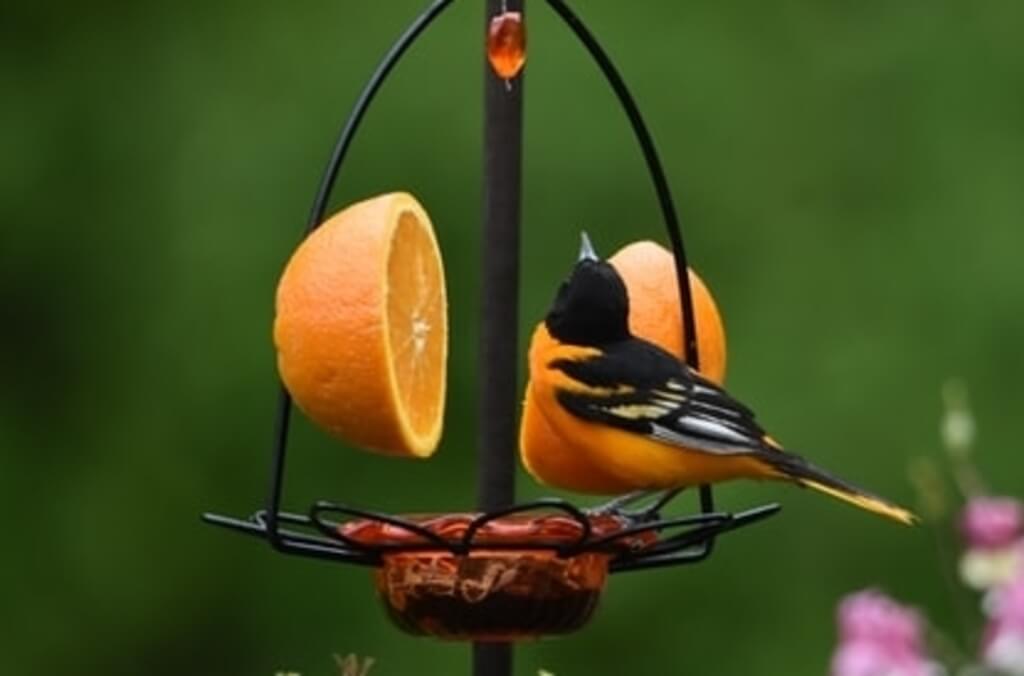
Conclusion
The Baltimore Oriole is a bird species that is known for its bright orange plumage and melodious song. As with all birds, proper nutrition is essential for their health and survival.
While Baltimore Orioles primarily feed on insects, fruits, and nectar, they have been known to consume dried mealworms as part of their diet.
Dried mealworms are a rich source of protein, calcium, and essential vitamins that can benefit the health of Baltimore Orioles.
Studies have shown that offering dried mealworms to Baltimore Orioles can increase their breeding success and overall health.
However, it is important to note that dried mealworms should not be the sole source of nutrition for these birds and should be offered in moderation.
An interesting statistic to note is that a study conducted by the Cornell Lab of Ornithology found that Baltimore Orioles that were given a diet including dried mealworms had a higher survival rate than those that did not receive them.
This highlights the potential benefits of including dried mealworms in the diet of Baltimore Orioles.

